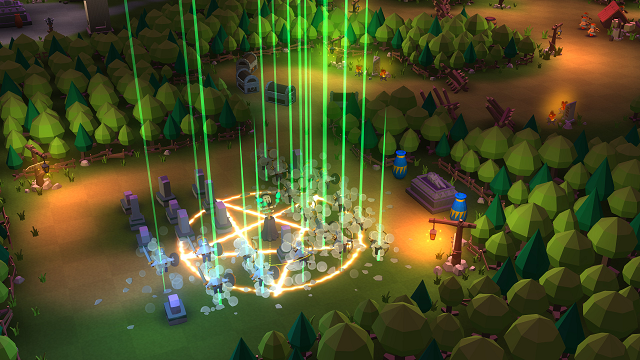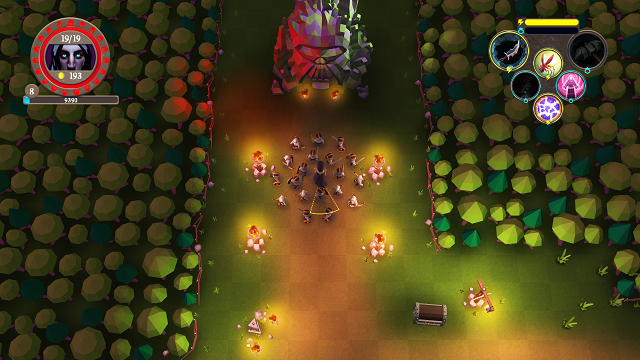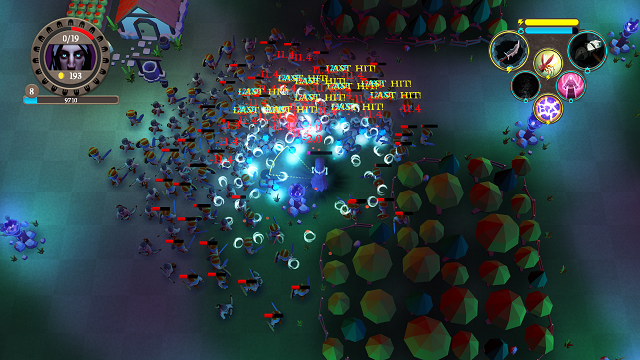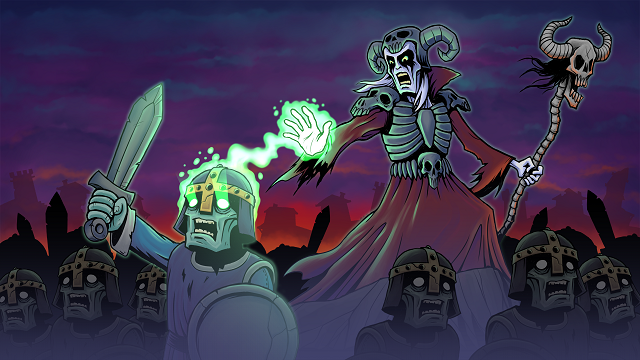Being a necromancer is tough — your school of magic is generally seen in an unfavorable light, your skill set forces you to spend a lot of time in really unsavory locations, and, worst of all, most of your friends are dead. In Undead Horde, a title developed and published by Finnish game studio 10tons Ltd. players get to experience this firsthand as they assume the role of one such spell casters
Undead Horde takes a light-hearted approach to the whole “raising the dead to do your bidding and destroy the living” thing. It lets players slaughter their enemies and bring them back to life to fight on their side. If that sounds appealing to you, then read on to find out whether or not Undead Horde is something that should stay buried.
To note, Undead Horde was in Steam Early Access at the time of writing. These impressions are based on version 0.9.0.6 of the game, which released on March 12, 2019.
Building a Better Zombie

The core gameplay in Undead Horde revolves around strategically building an army of undead warriors. This is done by defeating a variety of different enemies, each with their own strengths and weaknesses, in battle — after killing a certain number of a specific enemy type, that former foe will become summonable from the necromancer’s crypt.
As mentioned, there are many different enemy types to take control of. This includes humans, orcs, bears, and chickens, and, indeed, a big part of the fun of Undead Horde is putting together an army of undead and seeing how the different enemy types work with one another.
That is not all that the game has to offer, though — necromancers also level up as you play, which brings upgrades to several stats, improving things like the necromancer’s health, magic damage, and the amount of creatures they can control. This progression system provides an opportunity to tweak the types of strategies that will be employed based on what is deemed effective in your efforts to destroy the living.
Another core concept of Undead Horde revolves around the management of your different attributes during battle. Your necromancer can do a ton of damage with each hit, but it will quickly get burst down if your horde has fallen. Carefully managing your mana, health, and cooldowns during fights takes a lot of practice and split second decision making.
Fights are thus a fun combination of raw skill and strategic planning, and there are different options available. For example, do you want to pop your Raise Dead ability now to help you kill a giant scorpion? Or do you want to risk battling it with your weakened horde so that you can add it to your ranks when you do raise the dead? The choice is yours in Undead Horde.
The Skeleton Dance

All of the aforementioned gameplay elements come together in something pretty simple: Undead Horde looks like a twin stick shooter, and it works in a similar way. You move your necromancer with WASD, and change the direction it faces with the mouse. Clicking the mouse attacks and controls your magic, while a few keys help you manage inventory, raise corpses from the dead, and change skills.
The simplicity of these controls actually fits the game’s sensibility nicely. That is, Undead Horde has a straightforward style — cartoonish in both its look and its humor. It never tries to be overly clever, and it doesn’t take itself too seriously, which is just fine for a game like this.
However, this straightforward, simple approach also plays against Undead Horde in a couple of ways. For example, the different types of undead units you can summon aren’t developed enough to have a strong gameplay distinction from one another. This means that, too often, you will find yourself simply summoning the last enemy you unlocked, as there is not much strategic reason to do otherwise.
This also carries over to the visual aspect of these units, as many just look like skeletons wearing armor. This makes it too hard to differentiate them in the heat of battle, and it can become frustrating when you can’t even be sure of things like how many melee units you have left.
Indeed, successful games with top-down views always make it very clear which unit is which, and Undead Horde could greatly benefit from some distinction in its unit types, mainly with its non-animals. A little less simplicity would go a long way here.
“And the B-Boy Skeletons?” “Part of it!”

Another issue with Undead Horde comes from its lack of stakes. When you die, you simply go back to your crypt, and you’re just a quick teleport away from whatever map knocked you out. Additionally, the enemies that you killed in the map will still be gone upon your return.
While this does play into the idea of an undead army that simply never relents, a total absence of punishment for death means that success in Undead Horde can come without strategy or skill, as you can just haphazardly throw yourself at a problem until it is finally overcome. As examples, rushing down a boss without caring if you actually survive or bombing out a barracks and ignoring enemy soldiers become viable tactics, and they are far too effective.
This issue compounds with some of the others we’ve talked about to put Undead Horde in a poisonous category: a PC game that feels like a mobile game. While there is certainly nothing wrong with having some mindless fun on your Steam account, it simply feels like Undead Horde is missing the necessary elements to make it stand out in a crowded marketplace.
Keep in mind: Undead Horde is still in Early Access, as previously mentioned, and it’s entirely possible that some of these “missing” elements are on the way. That said, there is a pretty impressive… skeleton (I’m so sorry) in place, but, without a few tweaks, it is a tough game to recommend.







Published: Mar 13, 2019 11:05 am